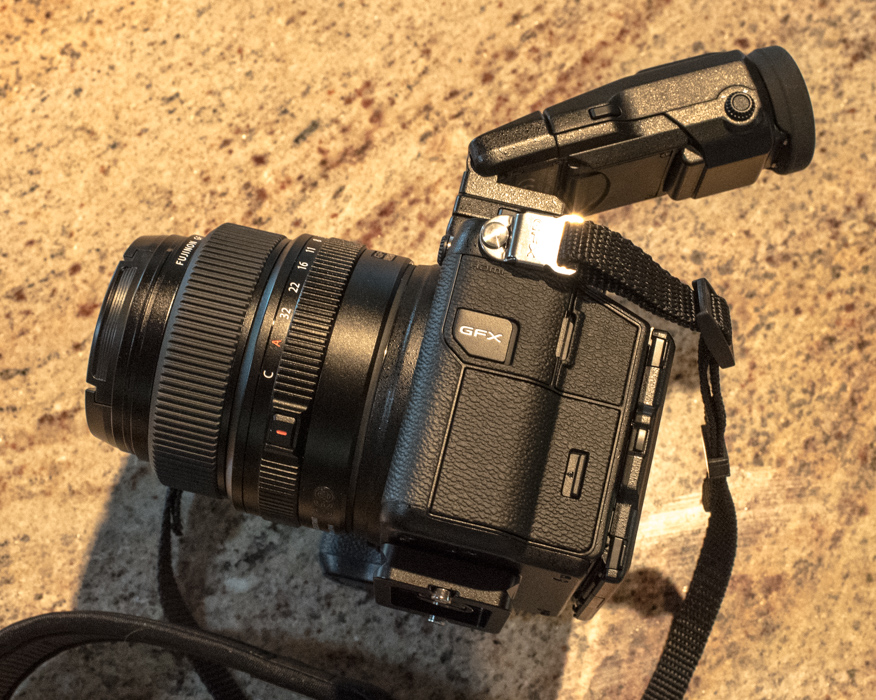A couple of weeks ago, I wrote a post about making a mistake and losing my place in the B&H line for the GFX. I said then that it would be a while before I reported on the camera. I was wrong. A GFX did the web equivalent of following me home, and I received one yesterday, a couple of weeks earlier than B&H was estimating when I still had my place in line there.
This will be the first post of the review. There will be permalinks to all of the other posts down at the bottom of this page, below the comments. In addition, there will be eventually be links to posts that answer some of the questions I have about the camera:
- How does it handle?
- Did they really get the ISOlessness right? I’m excited about this one; it seems like they’ve done the right thing and passed the digital gain off to the raw developer when the camera gets ISOless. [The answer turned out to be that they nailed it, IMHO]
- How well does it work with H-series Hasselblad lenses? [It’s a mixed bag. Here. Here. Here. Here.]
- How well do H-series Hasselblad lenses work with it? [ Fine with the focal plane shutter. Not at all with the leaf shutters.]
- How well do full frame lenses work with it? Which lenses work well, and what are the limitations?
- What’s the user interface like? I know it’s like other Fuji cameras, but the last one of those I had was more than 10 years ago.
- What raw processing happens in-camera? [Not much, as it turns out. That’s a good thing.]
- What are the sharpness/aliasing trade-offs involved with Fuji’s small microlens system?
- Is corner sharpness of adapted lenses adversely affected by the camera’s offset sensor cover glass? [Apparently not.]
Some things that I’m not particularly interested in, since they don’t affect my intended use of the camera:
- Autofocus speed, tracking, etc
- Performance of the native zoom lens
Feel free to add comments to this post requesting that I look into something I haven’t mentioned.
Here’s an apples to oranges comparison of my most-used camera these days, the Sony a7RII, and the GFX. The Sony has a rather large 50mm f/0.95 lens on it, plus a non-standard eye cup and a hotshoe-to-PC adapter. The GFX has a built-in PC connector, so it doesn’t need such an adapter. The GFX has the optional tilt/swivel EVF adapter and the 63mm f/2.8 (50mm f/2.2ish FF equivalent) lens.
The GFX has the CaNikon-like LCD screen on the desk of the camera; the Sony lacks that (a serious omission, IMHO). Both cameras have locks on the shutter-speed top dial, but the Fuji locks work the way that I think they should: you push down once to unlock, and the dial stays unlocked until you push down again. The Sony has an unlockable exposure compensation dial, and the GFX has a lockable ISO dial. I’d much rather have the exposure compensation dial, although it’s easy to change that on the Fuji by pressing a top-deck button and spinning a wheel, a la Nikon.
Both the Fuji body and the 63mm lens are remarkably light for their size.
Here’e a look at the left side of the GFX with the finder tilted to an intermediate position between the extremes of horizontal and vertical.
The EVF tilt/swivel adapter is a well-made, confidence-inspiring piece of kit, with locks for movement in each direction. It’s not small, however. Note the battery door on the left side of the camera, a design move that has incurred the ire of everyone who likes to use L-brackets.


Geronimo says
I am interested to know how the (difficult) Leica M wide angle lenses could work in the GXF. Specially for black and white (if there is a color shift). I know this are not ideal lenses but still it would be usefull for some uses.
Thank you
JimK says
Which ones? WATE? 18 SE? 24 Elmar? They’re all gonna be bad except maybe for the WATE. The question is how bad.
Geronimo says
Yes Jim; I use a lot of the old symmetrical lenses (including the 21 super angulon or the 15 hollogon but also the 18SE or the 12 voightlander) with the Leica M Monochrom. I am wondering if the GXF would be as good (for a wide angle black and white square format)?
Rudolf Klein says
No way. I think that below 35mm there is no possibility of using M lenses on the Fuji 33×44 sensor. Even on the M10 these wides have difficulties.
JimK says
The WATE does OK.
http://blog.kasson.com/the-last-word/leica-wate-on-fujifilm-gfx-50s-16-21-mm/
David Mane says
I’d love to be wrong about this. I’m a photographer of 40 years experience and I’ve used a Hasselblad film camera and Phase One mainly and a Canon 5d for fast work. The Fuji GFX looked great, the Phase One is worn out so I went in and being careful I put a card in a new 5d and a GFX and shot the same thing in the shop. I put the images next to each other and I thought the 5d image kinda looked better. Thinking I must have messed it up I went back to the camera shop and was way more careful, tripod, same settings etc. At the best I can’t see much difference. I’ve decided I’ll wait for the 100mp model but if anyone wants to look at my test images and tell me I’m wrong I’d be very happy to hear why. I was really looking forward to getting the GFX.